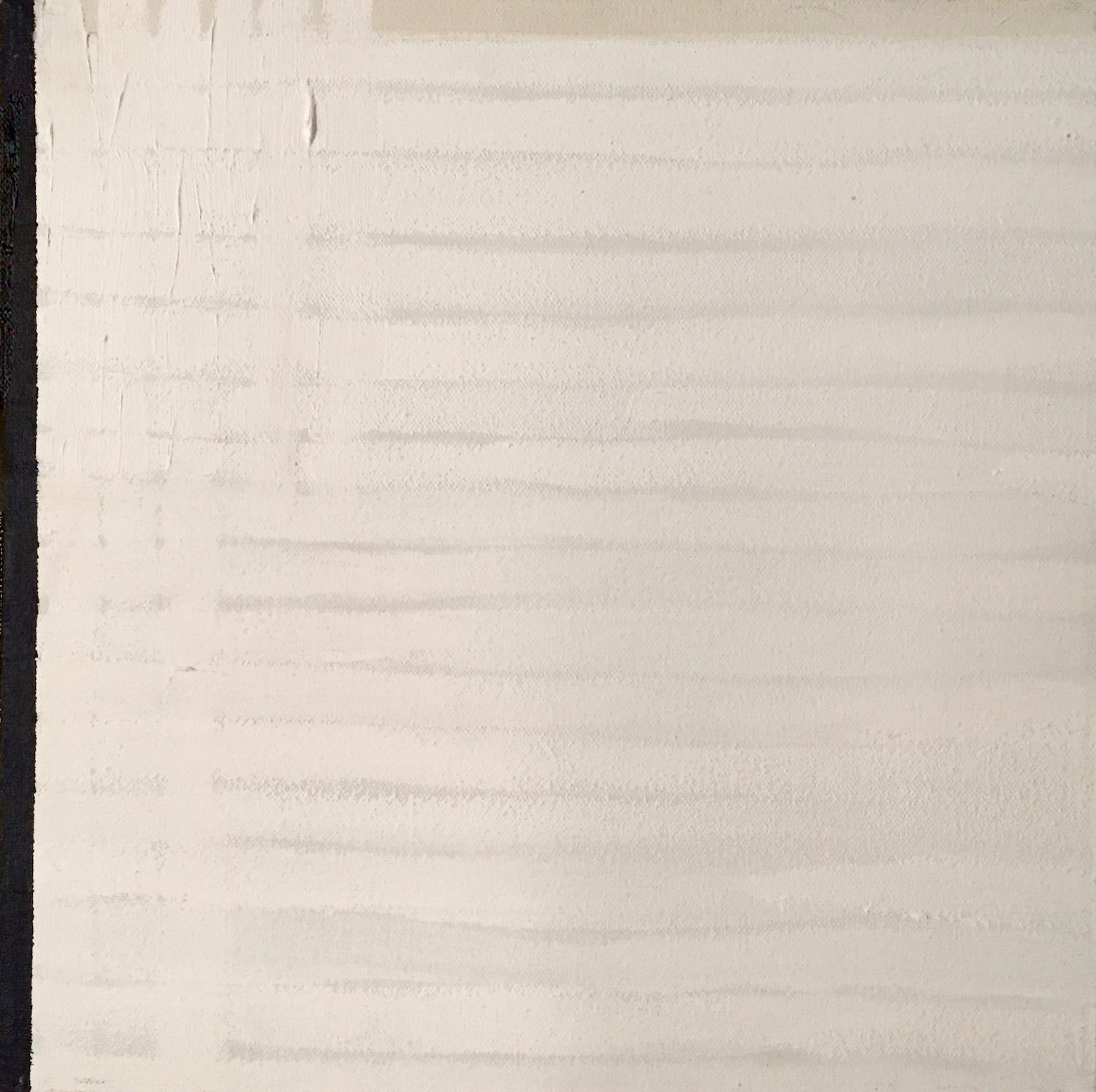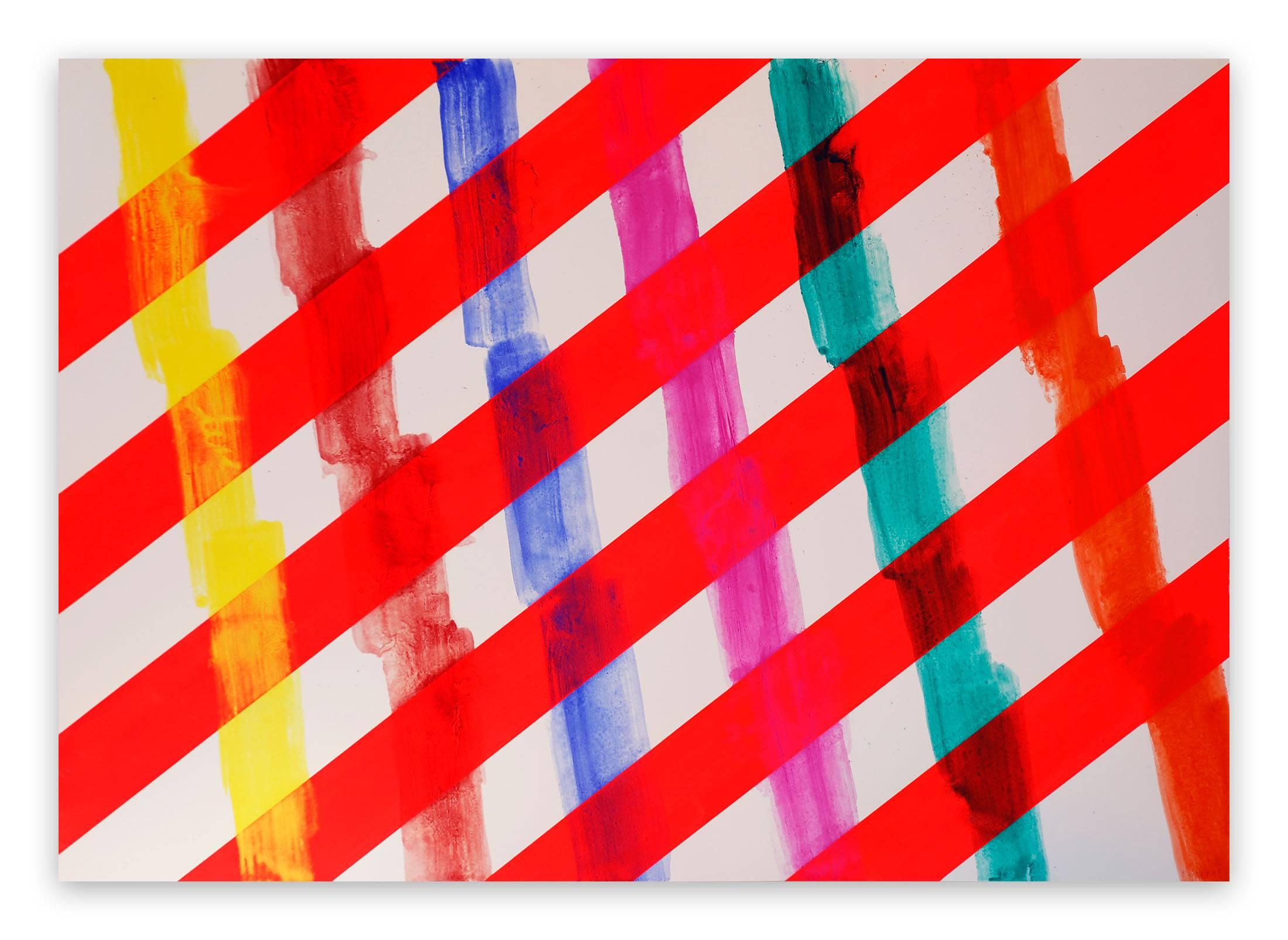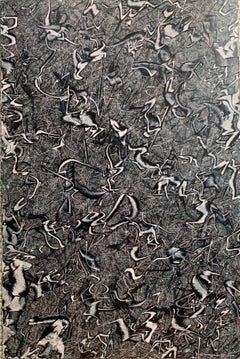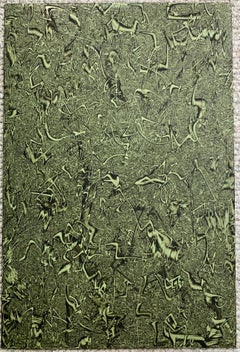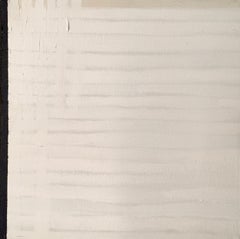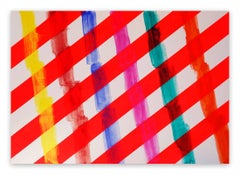Items Similar to Etude III (abstract expressionist painting)
Want more images or videos?
Request additional images or videos from the seller
1 of 9
Fredric KarolyEtude III (abstract expressionist painting)ca. 1960
ca. 1960
$2,500
£1,872.61
€2,164.64
CA$3,510.79
A$3,823.81
CHF 2,023.81
MX$46,785.55
NOK 25,043.05
SEK 23,639.10
DKK 16,156.35
About the Item
Fredric Karoly (1898-1987). Etude III, 1950. Oil on masonite panel measures 18 x 24 inches. Unframed. Signed, titled, dated on reverse. Good condition with minor paint loss at edges.
Biography:
An abstract painter, Karoly was born in Hungary and studied painting in Paris, architectural eingineering in Berlin, and emigrated to the U.S. in 1926. He began a successful career as a fashion and fabric designer. In 1948 he was working as a fashion director for Simplicity Patters, when he had a solo exhibition of of his oil paintings, wire montages, dry-pen drawings and abstract photography.
Solo Exhibitions:
Hugo Gallery (Alexandre Iolas) New York 1948; Gallery Mai. Paris 1949; New Gallery (Eugene Thaw) New York 1950; Museu de Arte, Sao Paulo, Brazil 1951; Miami Museum of Modern Art, Miami, Florida 1959; Loft Gallery, New York City, 1966.Group Exhibitions:
Hugo Gallery, New York 1947; Salon des Realities Nouvelles, Paris 1949-1953; Whitney Museum of American Art, New York (Annual) 1951-1953, 1963; Biennale of Sao Paulo, Brazil, 1951; International Independent Exhibition, Tokyo, 1951; Martha Jackson Gallery, New York, 1959; The Butler Institute of Art, Youngstown, Ohio, 1960; Stuttman Gallery, New York, 1960; The Art Institute of Chicago (Annual), 1960; International Watercolor Exhibition, Brookyln Museum, 1961; Westchester Art Museum, White Plains, NY, 1963; Whitney Museum, Annual, NY 1963; Cleveland Art Festival, Park Synagogue, Cleveland, 1963; Whitney Museum, Sculpture Annual, NY, 1964.Works in Institutional Collections:
Museu de Arte, San Paulo, Brazil; Museu de Bellas Artes, Buenos Aires, Argentina; New York University, New York; Washington University, St. Louis, Missouri; Finch College, NY; Barnard College, NY; Metropolitan Museum, Whitney Museum and Guggenheim Museum, New York; Museum of Fine Arts, St. Petersburg, FL.
Awards: National Council Arts Awards, 1968.
Frederic Karoly died on December 15, 1987 at the Inter-Continental Hotel in Manhattan, where he had made his home for many years.
Fredric Karoly was born in Budapest in 1893. According to Karoly’s own vitae, his exhibition history began in New York in 1947, when at the age of 54 he took part in a four-person group show at Hugo Gallery. His involvement with visual art however was apparently life long. In a brief introduction to his solo show at Galerie Mai in Paris in June of 1949, Jen Luc de Rudder, reports that Karoly began painting at the age of 12 in Budapest.
After several years of studying, then working in London, Paris and Berlin, Karoly emigrated to the United States in 1925 or 1926 (he probably first came to the US on a work visa in 1925). In New York, Karoly worked in women’s fashion as a designer.
In 1948 Karoly worked in a manner than was clearly influenced by the work of such European surrealists as Max Ernst, creating spiked automatic bi-chromatic paintings. His style progressed into a progressively more biomorphic vein, similar to explorations by Theodore Stamos, Daphnis, Milton Avery and Mark Rothko around the same period. He was supported with patronage during this period by Mrs. Mimi Baliff, who apparently supported the “Industrial Design Workshop” that she helped open to feature Karoly’s designs in 1948.
By the early 1950’s (1951) Karoly started experimenting with the drip and splatter process as well. Drip paintings dominated his process until the late 50’s-early 60’s, when linear compositional elements began to reemerge. By the late 50’s multi-layered drip grid motifs asserted a masque of spatial organization over looser washed fields and splatters of paint that Karoly worked off of. This development was consistent with concurrent explorations into the grid by artist Agnes Martin and others.
By the mid-50’s Karoly’s style began another transition into a more surface concerned “Color Field” style of painting. There are elements still reminding one of Abstract Expressionist concerns as such painters as Clifford Still. But the works that began to emerge from Karoly’s studio in 1958 presaged the Morris Lewis fan motifs and Friedl Dzubas’s epic and romantic color spewing expanses of canvas.
In 1959 Karoly began experiments using washes of turpentine diluted oil paint directly onto raw linen, and all of these subsequently suffered the consequences of oil oxidation and acidity upon the surfaces. However, many of Karoly’s washes in color field happily occurred on lightly prepared primed canvas surfaces as well.
By 1960 Karoly began reintroducing imagistic references to his visual content. There were also various references to Japanese and Zen influences. He experimented with a variety of processes that included mixed media and marbleized surfaces achieved by the intermixture of oil and water mediums. A calligraphic element also enter Karoly’s work in the early 60’s. Then in 1961 glued and assembled objects begin to show up in Karoly’s work in earnest. The influence of early POP artists, particularly Jasper Johns, and Robert Rauschenberg, become apparent. From 1961-63, a series of the assemblage works transition from canvas to the sculptural to pieces obviously intended for full scale installation. Many of these pieces were among the most fragile of his works primarily due to their reliance upon the of gluing of objects such as plastic or paper cups on flexible surfaces of stretched linen or canvas.
In the mid-60’s Karoly apparently produced a number of photo-silk screened series of Picasso, De Kooning and other significant artists of his generation. These were executed in a style somewhere between Rauschenberg’s and Roy Lichtenstein’s, primarily because of their reliance upon half tones and Ben-Day dot effects. Then Karoly began a series of paintings conflating his drip and grid styles with super imposed and painted over string. In the late 60’s Karoly embarked upon a series of multi-paneled stretched linen constructions often with slits and fiber optic back-lit elements that were prescient of the work of Dan Flavin and others. It was this body of work that was shown at Hofstra University’s Emily Lowe Gallery, and it was these works that suffered perhaps the most irreparable damage from a steam/water infiltration in a space where they were being stored.
The late professional start that Karoly had into the art world was balanced by his long life span and early immersion into the design issues of modernism as it emerged in turn of the century Europe and later evolved in America. He was clearly an artist who subscribed to the ethos of the new in abstraction and was obviously impressionable and in some instances prescient with regard to various trends in abstraction.
Several noteworthy and influential collectors and institutions during his 40 years of professional engagement acquired his work. The Whitney Museum of American Art had and may still own a large Karoly canvas from 1960, but this is doubtful as the artist failed to list it on the vitae he filed with MoMA in 1965. His work was recognized and honored by the Whitney with its inclusion in four of their annual survey shows (1951,1953, 1963 and 1964).
The artist’s surrealist influenced paintings from 1948-1950 were the focus of a solo exhibition held of his work by the Museo de Art in Sao Paulo and eight years later a ten year survey of his work was the focus of a solo show at the Miami Museum of Modern art. The Sao Paulo Museum in Brazil, and the Museo de Bellas Artes in Buenos Aires, Argentina each acquired Karoly paintings for their collections in the 1950’s.
One of Karoly’s surrealist pieces was apparently purchased by Christian Zervos, Picasso’s designated chronicler, who apparently also wrote a piece on Karoly in Cahiers D’Art in 1949. A 60’s piece of Karoly art that is in the New York University’s permanent collection is included in the MoMA Library’s catalog of Karoly transparencies. The Konigs, who amassed a serious collection of optical art in the early 1960’s purchased a Karoly from that genre. And former Governor and MoMA patron, Nelson Rockefeller apparently purchase a Karoly.
Each development in Karoly’s evolving oeuvre received some collector interest and Museum/gallery exposure. If his career was hampered by any single barrier it was by a lack or continuity and representation by a member of the inside circle of ADAA members.
The late Leo Castelli was aware of Karoly’s work and considered him talented and difficult to work with. Fellow Hungarian, the late Tibor de Nagy, who J.W. Phillips spoke with about Karoly two years before his death told Phillips that he almost decided to represent Karoly but encountered a series of disagreements with him concerning how his work might be represented in a tryout exhibition, which Karoly wound up canceling.
- Creator:Fredric Karoly (1898 - 1987)
- Creation Year:ca. 1960
- Dimensions:Height: 18 in (45.72 cm)Width: 24 in (60.96 cm)Depth: 0.1 in (2.54 mm)
- Medium:
- Movement & Style:
- Period:
- Condition:
- Gallery Location:Wilton Manors, FL
- Reference Number:1stDibs: LU245215616952
About the Seller
4.9
Platinum Seller
Premium sellers with a 4.7+ rating and 24-hour response times
Established in 2007
1stDibs seller since 2015
418 sales on 1stDibs
Typical response time: 2 hours
- ShippingRetrieving quote...Shipping from: Wilton Manors, FL
- Return Policy
Authenticity Guarantee
In the unlikely event there’s an issue with an item’s authenticity, contact us within 1 year for a full refund. DetailsMoney-Back Guarantee
If your item is not as described, is damaged in transit, or does not arrive, contact us within 7 days for a full refund. Details24-Hour Cancellation
You have a 24-hour grace period in which to reconsider your purchase, with no questions asked.Vetted Professional Sellers
Our world-class sellers must adhere to strict standards for service and quality, maintaining the integrity of our listings.Price-Match Guarantee
If you find that a seller listed the same item for a lower price elsewhere, we’ll match it.Trusted Global Delivery
Our best-in-class carrier network provides specialized shipping options worldwide, including custom delivery.More From This Seller
View AllEtude (abstract expressionist painting)
By Fredric Karoly
Located in Wilton Manors, FL
Fredric Karoly (1898-1987). Etude, 1950. Oil on masonite panel measures 18 x 24 inches. Unframed. Signed, titled, dated on reverse. Good condition with minor paint loss at edges.
Biography:
An abstract painter, Karoly was born in Hungary and studied painting in Paris, architectural eingineering in Berlin, and emigrated to the U.S. in 1926. He began a successful career as a fashion and fabric designer. In 1948 he was working as a fashion director for Simplicity Patters, when he had a solo exhibition of of his oil paintings, wire montages, dry-pen drawings and abstract photography.
Solo Exhibitions:
Hugo Gallery (Alexandre Iolas) New York 1948; Gallery Mai. Paris 1949; New Gallery (Eugene Thaw) New York 1950; Museu de Arte, Sao Paulo, Brazil 1951; Miami Museum of Modern Art, Miami, Florida 1959; Loft Gallery, New York City, 1966.Group Exhibitions:
Hugo Gallery, New York 1947; Salon des Realities Nouvelles, Paris 1949-1953; Whitney Museum of American Art, New York (Annual) 1951-1953, 1963; Biennale of Sao Paulo, Brazil, 1951; International Independent Exhibition, Tokyo, 1951; Martha Jackson Gallery, New York, 1959; The Butler Institute of Art, Youngstown, Ohio, 1960; Stuttman Gallery, New York, 1960; The Art Institute of Chicago (Annual), 1960; International Watercolor Exhibition, Brookyln Museum, 1961; Westchester Art Museum, White Plains, NY, 1963; Whitney Museum, Annual, NY 1963; Cleveland Art Festival, Park Synagogue, Cleveland, 1963; Whitney Museum, Sculpture Annual, NY, 1964.Works in Institutional Collections:
Museu de Arte, San Paulo, Brazil; Museu de Bellas Artes, Buenos Aires, Argentina; New York University, New York; Washington University, St. Louis, Missouri; Finch College, NY; Barnard College, NY; Metropolitan Museum, Whitney Museum and Guggenheim Museum, New York; Museum of Fine Arts, St. Petersburg, FL.
Awards: National Council Arts Awards, 1968.
Frederic Karoly died on December 15, 1987 at the Inter-Continental Hotel in Manhattan, where he had made his home for many years.
Fredric Karoly was born in Budapest in 1893. According to Karoly’s own vitae, his exhibition history began in New York in 1947, when at the age of 54 he took part in a four-person group show at Hugo Gallery. His involvement with visual art however was apparently life long. In a brief introduction to his solo show at Galerie Mai in Paris in June of 1949, Jen Luc de Rudder, reports that Karoly began painting at the age of 12 in Budapest.
After several years of studying, then working in London, Paris and Berlin, Karoly emigrated to the United States in 1925 or 1926 (he probably first came to the US on a work visa in 1925). In New York, Karoly worked in women’s fashion as a designer.
In 1948 Karoly worked in a manner than was clearly influenced by the work of such European surrealists as Max Ernst, creating spiked automatic bi-chromatic paintings. His style progressed into a progressively more biomorphic vein, similar to explorations by Theodore Stamos, Daphnis, Milton Avery and Mark Rothko around the same period. He was supported with patronage during this period by Mrs. Mimi Baliff, who apparently supported the “Industrial Design Workshop” that she helped open to feature Karoly’s designs in 1948.
By the early 1950’s (1951) Karoly started experimenting with the drip and splatter process as well. Drip paintings dominated his process until the late 50’s-early 60’s, when linear compositional elements began to reemerge. By the late 50’s multi-layered drip grid motifs asserted a masque of spatial organization over looser washed fields and splatters of paint that Karoly worked off of. This development was consistent with concurrent explorations into the grid by artist Agnes Martin and others.
By the mid-50’s Karoly’s style began another transition into a more surface concerned “Color Field” style of painting. There are elements still reminding one of Abstract Expressionist concerns as such painters as Clifford Still. But the works that began to emerge from Karoly’s studio in 1958 presaged the Morris Lewis fan motifs and Friedl Dzubas’s epic and romantic color spewing expanses of canvas.
In 1959 Karoly began experiments using washes of turpentine diluted oil paint directly onto raw linen, and all of these subsequently suffered the consequences of oil oxidation and acidity upon the surfaces. However, many of Karoly’s washes in color field happily occurred on lightly prepared primed canvas surfaces as well.
By 1960 Karoly began reintroducing imagistic references to his visual content. There were also various references to Japanese and Zen influences. He experimented with a variety of processes that included mixed media and marbleized surfaces achieved by the intermixture of oil and water mediums. A calligraphic element also enter Karoly’s work in the early 60’s. Then in 1961 glued and assembled objects begin to show up in Karoly’s work in earnest. The influence of early POP artists, particularly Jasper Johns, and Robert Rauschenberg, become apparent. From 1961-63, a series of the assemblage works transition from canvas to the sculptural to pieces obviously intended for full scale installation. Many of these pieces were among the most fragile of his works primarily due to their reliance upon the of gluing of objects such as plastic or paper cups on flexible surfaces of stretched linen or canvas.
In the mid-60’s Karoly apparently produced a number of photo-silk screened series of Picasso, De Kooning and other significant artists of his generation. These were executed in a style somewhere between Rauschenberg’s and Roy Lichtenstein’s, primarily because of their reliance upon half tones and Ben-Day dot effects. Then Karoly began a series of paintings conflating his drip and grid styles with super imposed and painted over string. In the late 60’s Karoly embarked upon a series of multi-paneled stretched linen constructions often with slits and fiber optic back-lit elements that were prescient of the work of Dan Flavin and others. It was this body of work that was shown at Hofstra University’s Emily Lowe Gallery, and it was these works that suffered perhaps the most irreparable damage from a steam/water infiltration in a space where they were being stored.
The late professional start that Karoly had into the art world was balanced by his long life span and early immersion into the design issues of modernism as it emerged in turn of the century Europe and later evolved in America. He was clearly an artist who subscribed to the ethos of the new in abstraction and was obviously impressionable and in some instances prescient with regard to various trends in abstraction.
Several noteworthy and influential collectors and institutions during his 40 years of professional engagement acquired his work. The Whitney Museum of American Art had and may still own a large Karoly canvas from 1960, but this is doubtful as the artist failed to list it on the vitae he filed with MoMA in 1965. His work was recognized and honored by the Whitney with its inclusion in four of their annual survey shows (1951,1953, 1963 and 1964).
The artist’s surrealist influenced paintings from 1948-1950 were the focus of a solo exhibition held of his work by the Museo de Art in Sao Paulo and eight years later a ten year survey of his work was the focus of a solo show at the Miami Museum of Modern art. The Sao Paulo Museum in Brazil, and the Museo de Bellas Artes in Buenos Aires, Argentina each acquired Karoly paintings for their collections in the 1950’s.
One of Karoly’s surrealist pieces was apparently purchased by Christian Zervos, Picasso’s designated chronicler, who apparently also wrote a piece on Karoly in Cahiers D’Art in 1949. A 60’s piece of Karoly art that is in the New York University’s permanent collection is included in the MoMA Library’s catalog...
Category
Mid-20th Century Abstract Expressionist Abstract Paintings
Materials
Masonite, Oil
Untitled (ER 53) Abstract Expressionist Painting
Located in Wilton Manors, FL
Edward Pechmann Renouf (1906-1999). Oil on masonite panel, measures 16 x 24 inches. Excellent condition. Signed lower right.
Provenance: Allan Stone Projects, New York, NY.
Biography:
Birth place: Hsiku, China
Addresses: East St. Washington, CT
Profession: Painter, sculptor
Studied: Phillips Andover Acad., 1924; Harvard Univ., 1928; Columbia Univ., 1936-46; drawing & painting with Carlos Merida...
Category
1970s Abstract Expressionist Abstract Paintings
Materials
Masonite, Oil
$1,200 Sale Price
20% Off
Untitled (ER51) Abstract Expressionist painting
Located in Wilton Manors, FL
Edward Pechmann Renouf (1906-1999). Oil on panel measures 16 x 24 inches. Signed lower margin. Excellent condition.
Provenance: Allan Stone Pr...
Category
1970s Abstract Expressionist Abstract Paintings
Materials
Masonite, Oil
$1,200 Sale Price
20% Off
Untitled (ER41) Abstract Expressionist painting
Located in Wilton Manors, FL
Edward Pechmann Renouf (1906-1999). Oil on panel measures 16 x 24 inches. Signed lower margin. Excellent condition.
Provenance: Allan Stone Pr...
Category
1970s Abstract Expressionist Abstract Paintings
Materials
Masonite, Oil
$1,200 Sale Price
20% Off
Untitled (ER44) Abstract Expressionist painting
Located in Wilton Manors, FL
Edward Pechmann Renouf (1906-1999). Oil on panel measures 16 x 24 inches. Signed lower margin. Excellent condition.
Provenance: Allan Stone Pr...
Category
1970s Abstract Expressionist Abstract Paintings
Materials
Masonite, Oil
$1,200 Sale Price
20% Off
Untitled (ER49) Abstract Expressionist painting
Located in Wilton Manors, FL
Edward Pechmann Renouf (1906-1999). Oil on panel measures 16 x 24 inches. Signed lower margin. Excellent condition.
Provenance: Allan Stone Pr...
Category
1970s Abstract Expressionist Abstract Paintings
Materials
Masonite, Oil
$1,200 Sale Price
20% Off
You May Also Like
Untitled, (abstract 3)
By Andrea Stajan-Ferkul
Located in Mississauga, Ontario
This contemporary minimal abstract painting places emphasis on simplified composition. Textures and patterns play a role in this minimal yet compelling work. Aesthetically calm, the ...
Category
21st Century and Contemporary Modern Abstract Paintings
Materials
Acrylic, Canvas
Untitled 10 (Abstract painting)
By Claude Tétot
Located in London, GB
Acrylic and oil on paper - Unframed
Claude Tétot is a French abstract artist whose work expresses harmony in disharmony by exploring the enigmatic unity that can exist between seemi...
Category
2010s Abstract Expressionist Abstract Drawings and Watercolors
Materials
Paper, Oil, Acrylic
Untitled 10 (Abstract painting)
By Claude Tétot
Located in London, GB
Untitled 10 (Abstract painting)
Acrylic and oil on paper - Unframed
Claude Tétot is a French abstract artist whose work expresses harmony in disharmony by exploring the enigmatic ...
Category
2010s Abstract Expressionist Abstract Drawings and Watercolors
Materials
Paper, Oil, Acrylic
Untitled 10 (Abstract painting)
By Claude Tétot
Located in London, GB
Untitled 10 (Abstract painting)
Acrylic and oil on paper - Unframed
Claude Tétot is a French abstract artist whose work expresses harmony in disharmony by exploring the enigmatic ...
Category
2010s Abstract Expressionist Abstract Drawings and Watercolors
Materials
Paper, Oil, Acrylic
Untitled 10 (Abstract painting)
By Claude Tétot
Located in London, GB
Untitled 10 (Abstract painting)
Acrylic and oil on paper - Unframed
Claude Tétot is a French abstract artist whose work expresses harmony in disharmony...
Category
2010s Abstract Expressionist Abstract Drawings and Watercolors
Materials
Paper, Oil, Acrylic
Untitled oil on canvas painting Abstract Expressionism
By Deyan Valkov
Located in Barcelona, Barcelona
Title: Untitled
Artist: Deyan Valkov
Medium: Oil on canvas
Dimensions: 24 x 20 inches
Year: 2002 (signed on the artwork)
Frame: Unframed
Style: Abstract Expressionism
Description of...
Category
Early 2000s Abstract Expressionist Abstract Paintings
Materials
Canvas, Oil
$1,141 Sale Price
52% Off
